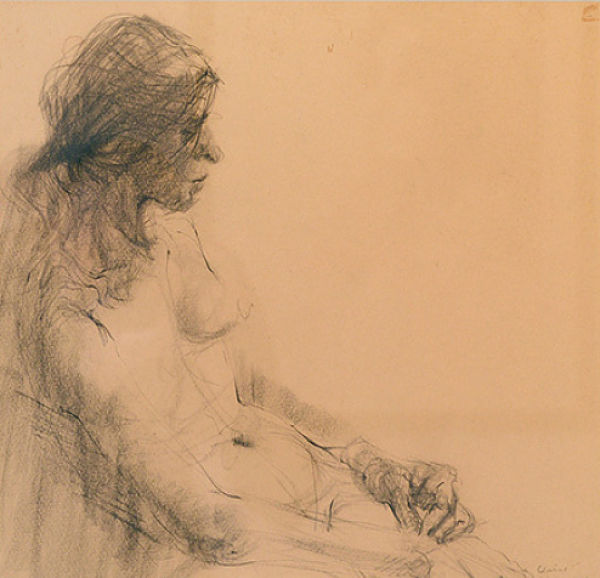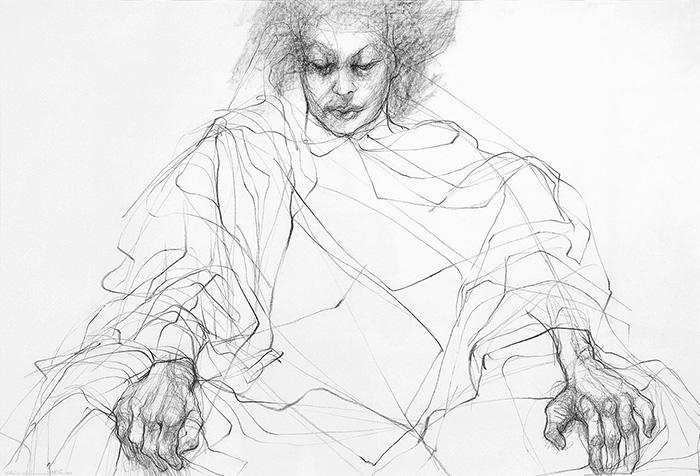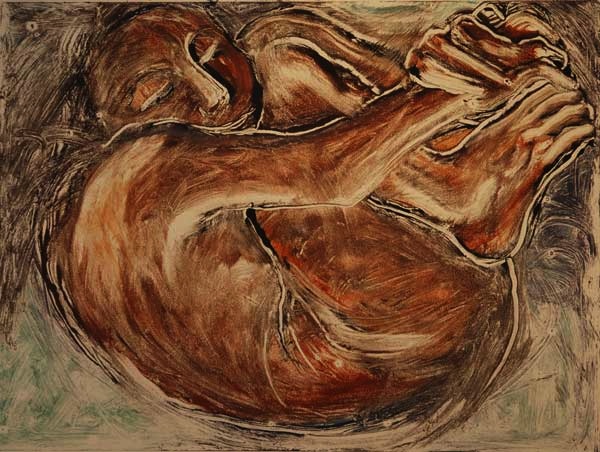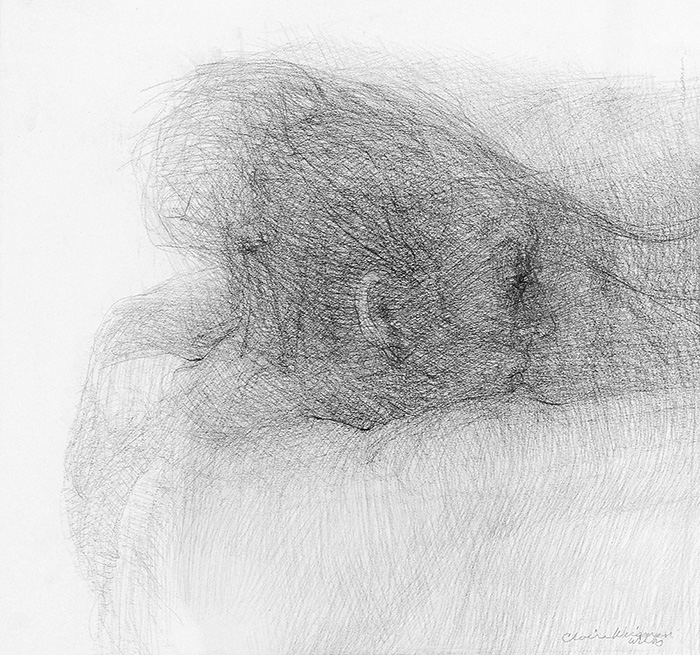What The Hand Sees
 Claire Weissman Wilks, Self Portrait, 1963 (detail), oil and dry brush on paper, 26.5 x 22 inches
Claire Weissman Wilks, Self Portrait, 1963 (detail), oil and dry brush on paper, 26.5 x 22 inches
In the 1980’s, after reading Etty Hillesum’s diary, Claire Weissman Wilks made some 20 drawings, her “Etty” series. As always in her work there is no landscape, no object, no clothing, or other “defence,” except sometimes a shroud, no food or shelter; and there is no deconstruction of form. As always in her work, there is “nothing but” the profound intensity of the naked human body – its immense moral power and mortal vulnerability. To explore historical events and to ask the most difficult questions through an exploration of the body – this requires the deepest humility. It requires the kind of rigour that is only possible after decades of disciplined work, when technique has become so intuitive that the hand has become “free”. It is a freedom that can only be earned. In the “Etty” series each line is alive and essential to the others. There is a silence surrounding these drawings that comes from an intense inner focus and conviction. This is Etty’s journey and this is Weissman Wilks’ profound solidarity with that journey.
 Daddy’s Day Girl, 1967, Conte crayon, 34.3 x 34.3 cm. Photo: Walter Willems
Daddy’s Day Girl, 1967, Conte crayon, 34.3 x 34.3 cm. Photo: Walter Willems
The “Etty” series is suffused with dispossession of every kind and with a fierce embrace of life, often in a single line. The drawings recognize the fact that all lives are lost “mid-stream,” gaping with intentions and desires; recognize that there are many possible lives lost in a single life.
 Mother Russia, 1982, Conte crayon, 99 x 68.6 cm. Photo: Walter Willems
Mother Russia, 1982, Conte crayon, 99 x 68.6 cm. Photo: Walter Willems
In her drawings, monoprints and sculptures, the body is not a symbol. Abstractions find form in these bodies yet their flesh is always powerfully real. How much longing, fear, passion, self-knowledge, tenderness, joy, abysmal loneliness, grief, resignation, despair, is in the position of a foot, the weight of a limb or breast, the folding or grasp of a hand, bodies so full they are empty, so empty they are full. For this is love “sunk past its gleam” as Seamus Heaney wrote: “these are bodies steeped in physical sensation, emotion, and self-realization, an immersion so total it tips towards the insensate.” For all their intertwining, Weissman Wilks’ figures often possess a haunting solitude. No one has drawn this with great accuracy (and with lines of such fluid precision) – both the solitude we leave behind when we love without restraint, and the solitude at the very core of grief. In her series, “Tremors” and “Out of the Cave” her figures eat love to this core.
 Out Of The Cave Series, 2008, monoprint, 61 x 46 cm
Out Of The Cave Series, 2008, monoprint, 61 x 46 cm
This exhibition represents decades of concentrated work. Images of intense physical intimacy – love and desire, submission to another and to sensation or emotion, the power and powerlessness of maternity, images of complex human pain in wars in different times and parts of the world.
In each drawing, an entire life is brought to the moment. Moments of devastating loneliness and devastating trust, openness splayed like a wound. The artist carries nothing with her, she carries everything with her. Paper and a stick of conte. “Drawing” with a brush on stone or glass. The page may be empty but the hand says what it sees. This is the mastery of an artist who comes to her work with absolute control and abject vulnerability.
 She Ite Holired Abbles, 1972, Conte crayon, 31.75 x 31.75 cm. Photo: Walter Willems
She Ite Holired Abbles, 1972, Conte crayon, 31.75 x 31.75 cm. Photo: Walter Willems
There is so much tenderness in Claire Weissman Wilks’ line of flesh, and so much courage in this tenderness.
*Essay for Claire Weissman Wilks’ cataloque From The Beginning, De Luca Fine Art / Gallery, March 28 – April 28, 2013.
Anne Michaels – Author of Fugitive Pieces
